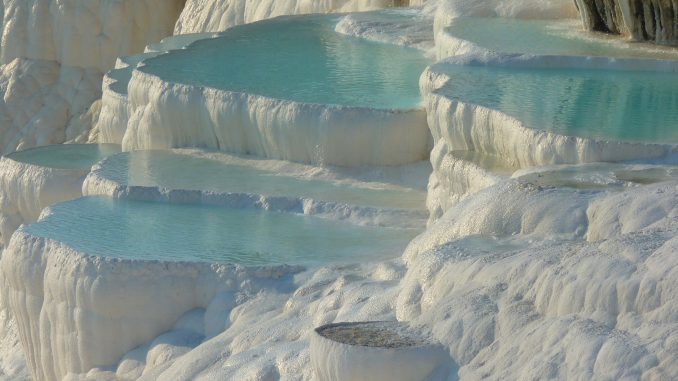
Made of white limestone and travertine terraces, the thermal springs in the Denizili Province of southwestern Turkey are the world’s most famous hot springs. Since classical antiquity people have been drawn to the thermal springs in this region and the calcium rich, limestone pools slowly sculpted by nature for thousands of years.
While the natural wonder of Pamukkale is the most common reason for visiting the site, there are some amazingly well preserved Roman ruins and a museum that is unadvertised and highly underestimated.
With more than 2 million people visiting the springs each year, Pamukkale is the biggest and busiest attraction in Turkey. This interest from tourists is not new as the site has been attracting attention since the time of Cleopatra, but the 2 million people at the site has added stress to the natural environment as well as the tourist infrastructure of the natural wonder.
Pamukkale Facts
- Legend has it that the formations are solidified cotton (the area’s principal crop) left out by giants to dry.
- When Pamukkale and Heirapolis was declared a UNESCO World Heritage Site in 1988 the hotels and the roads were removed and replaced with artificial pools.
- Pamukkale is actually more than 100 meters tall and may be seen from Denizli 20 km away.
- Pumukkale translates to “cotton castle”.
- More than 2 million people visit the springs annually and it is Turkey’s most visited attraction.
- The water in the springs ranges from 95°F (35°C) to 212°F (100°C).
- The Sacred Pool in Pamukkale is also known as Cleopatra’s Pool because she once swam there.
Pamukkale Travel Tips
- Day trips from Aegean and Mediterranean resorts can be grueling and can take several hours. The easiest way to get there is to hire a private car (this will still take 3-5 hours).
- Minibuses make the trip between Denizli’s bus station and Pamukkale frequently and only take about 40 minutes.
- The most stress free way to enjoy Pamukkale without the crowds is to spend the night in Pamukkale village and explore the formations and ancient sites in the morning before the day-trippers arrive in the afternoon.
- Late-afternoon/dusk are especially busy.
- Visit in the winter. November to March are the slow seasons and while it can be cold (sometimes even snowy) there are almost no crowds and the sites are still beautiful.